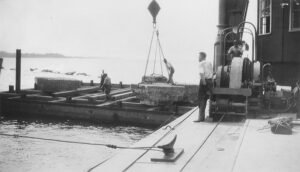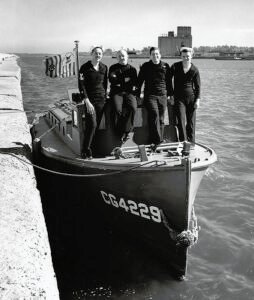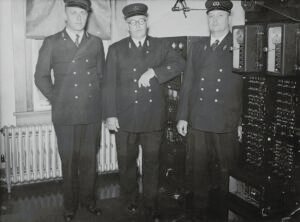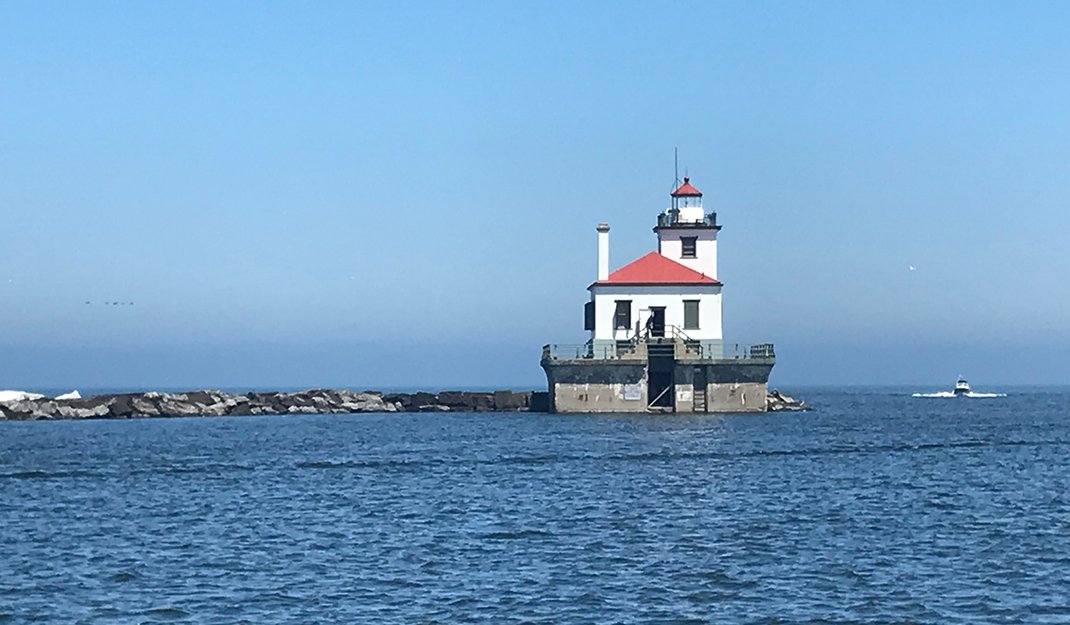Oswego’s iconic harbor beacon undergoes historic facelift and renovation — this time, inside the structure
By Tom and Jerry Caraccioli

For more than two centuries the Oswego Harbor lighthouse has enjoyed a fabled existence serving weary sailors of Lake Ontario as a beacon of light to a safe harbor and the city of Oswego and its residents as a touchstone to their roots.
“The first lighthouse in Oswego was built in 1822,” Michael Pittavino, curator at H. Lee White Maritime Museum in Oswego explained. “In 1837, the tall conical tower was built. In 1881, the Breakwater Beacon was built. And the current lighthouse was built in 1934, the longest serving lighthouse in the history of the city.”
The current lighthouse is the fourth in Oswego’s storied Great Lakes history. What is seen today when residents and visitors look out into the harbor was part of a much larger harbor improvement project 90 years ago that gave — and still gives — Oswego Harbor its present-day configuration with the two arrowhead break walls. Prior to the 1934 project, Oswego Harbor was much smaller. The improvements were made to replace the 1881 Breakwater Beacon, build break walls, as well as the current structure.
In addition to serving as a guiding light to vessels sailing along Lake Ontario, the Oswego West Pier Lighthouse also was a weather station in which the keepers would physically record weather data, including during the many tumultuous lake effect snowstorms that whipped across from Canada. The data would be transmitted to the National Weather Service for public broadcast. The site was outfitted with radio beacon technology, which was novel and slightly more modern in the 1930s. The radio beacon technology also served as a third ‘aid to navigation’ element of the lighthouse in the event the lights and horns faltered.

Dec. 4, 1942. Image courtesy of the Oswego County Historical Society.
“At the Oswego West Pier Lighthouse, keepers had a lot of different responsibilities,” Pittavino said. “Not only were they responsible for maintaining the light, they also were responsible for maintaining the structure. The head keeper would write logs and perform all of the administrative duties.”
In 1939, the U.S. Coast Guard took control of all the lighthouses in the country and members of the Coast Guard became keepers of the “lived in” lighthouse. Before that, keepers were part of the U.S. Lighthouse Service (1934-39). Groups of three manned the lighthouse 48 hours on, 24 hours off in a consistent rotation. It was outfitted like a home with amenities to live in — two beds (for three men, one was always on duty), kitchen and radio room — but didn’t have the feel of a home. The lighthouse also had all the typical facilities that made it a functional site including a water infiltration and intake system. Sewage was much more primitive nine decades ago and an electrical input was in the basement making it unique because the lighthouse was electrified. The three previous lighthouses had keepers that used oil-powered lanterns as beacons.
In the maritime annals of the Great Lakes and the city of Oswego, Dec. 4, 1942, is a day that many may not know the historical significance. But for Port City residents old enough to remember, it’s probably a date they have never forgotten.
On that fateful day nearly 82 years ago, six Oswego Coast Guardsmen lost their lives in the Oswego Harbor trying to save one of their own. During a lull in a turbulent, early-season storm that battered the city for several days with 65 mph winds and huge waves, Commanding Officer LTJG Altson J. Wilson piloted a 38-foot picket boat to go retrieve the current lighthouse keeper Karl H. Jackson. Jackson had been stranded in the lighthouse for three days and was running short on supplies because of the storm.
Wilson, along with nine others including two relief lighthouse keepers, Bert Egelston and Carl Sprague, set out in the standard response boat from the U.S. Coast Guard Lifeboat Station on the east side of the Harbor. Following the successful exchange of keepers and supplies, problems began as the westward winds pulled the boat and crew towards the east break wall. Despite efforts to anchor the boat, the winds were too strong. The 10-man crew crashed into the east break wall and capsized. Four members of the crew were able to climb onto the break wall, while six others perished — including Wilson and Jackson — in what is still one of the most noted tragedies in the history of the Great Lakes.

Twenty-six years later the last keepers moved out of the lighthouse during the period of automation, meaning the controls for the light to the Coast Guard Station were moved onshore. Among other things during the tumultuous times of 1968, that proved to be the end of the lighthouse-keeping profession in Oswego, but not the lighthouse.
In 2009, the U.S. Coast Guard had to, by law, offer to sell the lighthouse to the municipality of Oswego before offering it for private sale. The city acquired it. Five years later the H. Lee White Maritime Museum became the arbiters and managers when they leased the site in 2014 and then spearheaded its restoration two years later. Today the H. Lee White Maritime Museum begins its eighth season of educational access and tourism chronicling the story of more than 400 years of regional maritime history with exhibits, collections of thousands of artifacts, images, archival records, original artworks, as well as a tour of the lighthouse. The tour includes a pontoon ride out to the lighthouse where visitors have the chance to go inside and explore the three levels of the structure from the basement to the lantern deck.
“The preservation of the structure is really important to us and the community because it is so deeply enmeshed in the local culture and serves as a great tourism and historic asset,” Pittavino said. “It is still an active, working ‘aid to navigation.’”
While the exterior of the current 90-year-old harbor edifice is complete, the renovation plans have moved inside. The original hardwood floors from 1934 are being restored. When the floors are finished, sometime this year, the Maritime Museum will begin outfitting the lighthouse to return it to its ‘lived in’ look and feel so that visitors will be transported back in time to experience life as a lighthouse keeper.
Roughly 90% of the people that work at the H. Lee White Maritime Museum are volunteers from Oswego that comprise a corps of 30. They are people who invest their time and expertise to help make these projects and museum a success for the community. With more than 800 tourists visiting from June through September, one-hour Oswego Lighthouse tours begin on June 21, Fridays through Sunday and sometimes Thursdays and are $35 per person, $20 for children 12 years old and younger.
Throughout its 202-year maritime existence, the Oswego landmark’s collective light still shines bright and serves as a beacon to a safe harbor in a port city that always has opened its arms to the strong and sometimes weary, seafaring vessels and sailors of Lake Ontario.
Remembering a Tragic Day: Dec 4, 1942
Dec. 4, 1942, in Oswego is a forever reminder of how treacherous and unforgiving Lake Ontario can be. Seventy-five years have passed since six Oswego Coastguardsmen lost their lives in Oswego Harbor during an exchange of keepers at the Oswego West Pierhead Lighthouse.
During a prolonged and historic storm that produced 65 mph winds and huge waves, Keeper Karl H. Jackson had been stranded at the Lighthouse for three days and was running short on supplies. On the morning of the fourth the winds had slightly subsided, and at just past 10a.m., the 38-foot Picket boat left the USCG Lifeboat Station on the east side of the Harbor to relieve Jackson.
On board the vessel piloted by the station’s commanding officer LTJG Altson J. Wilson, were relief keepers Bert Egelston and Carl Sprague, as well as eight Coastguardsmen needed to control the vessel as it moored along the lee of the breakwater to make the exchange.
The exchange of keepers was made successfully, but as the wooden hulled boat backed away from the caisson foundation of the lighthouse, the engine failed. As the boat drifted east toward the mouth of the harbor, Machinist’s Mate Fred Ruff was able to start the engine twice, but it continued to stall out. Lt. Wilson ordered the 125-pound anchor dropped to stall the drift, yet within two minutes the line snapped, and the vessel continued toward the east breakwater where her port side crashed into the jagged rocks rolling her over plummeting the crew into the frigid and waters. Of the ten men on -board the 38-foot picket boat, four were able to reach the east arrowhead breakwater.
Once the situation was noticed by the crew still at the station, Second Class Boatswain’s Mate Robert Burnet – left in charge of the station – was able to get the 36-foot motor lifeboat underway for a heroic and risky rescue. LTJG Altson Wilson, BM1 Karl Jackson, BM2 Eugene J. Sisson, MM2 Ralph J. Sprau, SN1 Leslie J. Holdsworth, and SN2 Irving Ginsburg all lost their lives that day in Oswego Harbor.
 Tom and Jerry Caraccioli are freelance writers originally from Oswego, N.Y. who have co-authored two books: STRIKING SILVER: The Untold Story of America’s Forgotten Hockey Team and BOYCOTT: Stolen Dreams of the 1980 Moscow Olympic Games.
Tom and Jerry Caraccioli are freelance writers originally from Oswego, N.Y. who have co-authored two books: STRIKING SILVER: The Untold Story of America’s Forgotten Hockey Team and BOYCOTT: Stolen Dreams of the 1980 Moscow Olympic Games.




